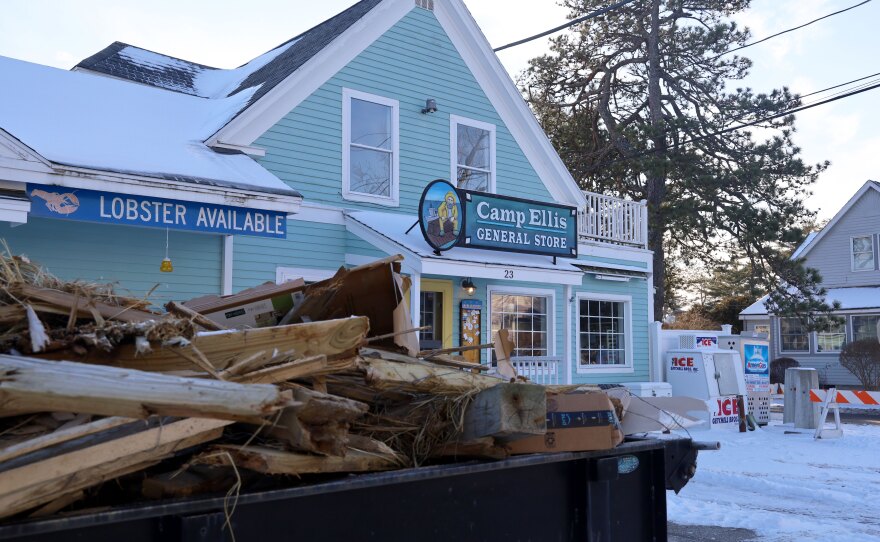The waves gently lap the beach on a cold, but bright January day at Camp Ellis in Saco. It's hard to believe that a few days ago, the view from David Plavin's windows was enough to send him packing. He left for a friend's house, beating out a storm that flooded his Camp Ellis neighborhood in Saco and set high tide records up and down the coast.
"The waves will break over the top of my house," he said. "We get a lot of splash-over, and you can see the force. If you look at this seawall here, this whole seawall is just totally caved in."
The storm ripped siding from his home. His roof is damaged, and his stone patio is destroyed. Plavin said he's experienced a handful of intense storms since he moved to this home seven years ago. But two of them whipped through Maine this month, flooding coastal communities, destroying piers and wharves and washing out public roads.
State officials are seeking a federal disaster declaration for the two storms, and many coastal communities are still assessing the damages. The one-two-punch comes as many communities in central and western Maine are still cleaning up from a storm in December that brought major flooding to riverfront towns.
"It gets to be a little discouraging," Plavin said. "I think a lot of people down here are starting to feel that way."

A few weeks earlier, heavy rain and snowmelt brought catastrophic flooding to three of Maine’s large river systems, causing at least $20 million in damage to public infrastructure.
That’s not including what private home and business owners like Christal Treadwell have lost, who was counting up the damages on the day after the mid-December storm.
"One, two, three, four, five, six seven vehicles," she said. "The snowmobiles, the motorcycle, the golf cart..."
Treadwell runs a wedding venue on her property in the western Maine town of Mexico. She recalls watching the water from the Androscoggin River rise and quickly flood her front yard. Eventually, the water reached her windows.
"The water wasn’t receding, it was actually getting higher. I said it’s time to go. So my stepson and his friend came with a boat," she said.
Treadwell, her husband and three dogs were evacuated. Her tenants who live in the apartments upstairs also left safely.
The three storms have served as a wakeup call for Maine, said Hannah Pingree, director of the Governor's Office of Policy Innovation and the Future. She's also a co-leader of the Maine Climate Council, which has been helping communities plan for climate change.
"We thought we had time to make some of these changes, to raise up wharves, to think about what happens to homes and infrastructure that are right on the ocean or right near floodplains," she said. "I think people now feel like OK, we understand what we need to do, but we need to do it more quickly."
In Camp Ellis, many residents are looking for more action, more quickly. Dozens of homes in the neighborhood have been lost to the ocean since the federal government constructed jetties at the mouth of the Saco River over the last two centuries.
After decades of debate, there's a plan to build a new, stone spur jetty to block waves that have been eroding the coastline.
But the Army Corps of Engineers is a few years away from starting the work. And some residents worry that by then, it won't be enough.
"We can't wait until 2025 or 2026 or 2027," said Camp Ellis resident Joe Kehoe. "It has to be 2024, like tomorrow. Or we're gone."

Kehoe moved from rural Massachusetts to Camp Ellis four years ago. He spent summers on the beach near Boston during his childhood and fell in love years later with this house steps from the ocean.
"You didn't see water like this, but that's what made me want to come here," he said. "I grew up near Revere Beach, so I wanted to bring that back. And I did."
But now Kehoe is dealing with a big mess. The storms wiped out much of the sand underneath his home. Jersey barriers serve as a makeshift seawall between the ocean and his house.
"I'm scared. I'm going to be very honest with you," he said. "I'm very scared."
In the aftermath of severe storms like these, scientists in Maine say communities should pursue three kinds of responses. They can adapt by rebuilding structures higher. They can avoid, by not building new infrastructure in hazardous places. Or, they can retreat, leaving vulnerable locations behind entirely.
Maine officials say all options are on the table.
For now, David Plavin said he'll repair his wooden seawall, but not the patio. He's not ready to give up on the property in Camp Ellis.
"I don't want to leave, but you don't want to lead the rest of your life and wonder when the next one's coming," Plavin said.
As for Joe Kehoe, he said he may rebuild and bolster the seawall in front of his home or jack the house up on stilts. Even though the prospects are daunting, he wants to stay too, as long as he can.







